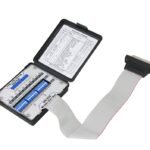Computers and networking gear
The MIT swapfests always have a wide array of computers for sale. This time, it was almost entirely laptops. Of those, most were Windows machines but a few Macs were on display. There was also an assortment of networking gear such as switches, routers, and cables.
Page 1 Audio equipment from reel-to-reel tape recorders to racks of equalizers.
Page 2: Components from connectors to vacuum tubes
Page 3: Computers and networking gear
Page 4: Radios, some older than your grandparents
Page 5: Test equipment, including something brand new by swapfest standards
Page 6: Hand tools and unidentified objects
Page 7: What I bought










Great peek inside the MIT Swap and not being within 500 miles makes it a bit hard to make it.
I would like to make a comment about the caption that you have on the old TSR-80 computer. Sure it’s only $100 but “…Good luck finding software to run on it.” There are hundreds of retro computer enthusiasts online. The one thing that drives most of us is the preservation of systems and software for these retro computers. Search twitter for #retroComputing or #retroGaming since most of the time the things we want to preserve are the games from our youth.
In the TSR-80 niche you can find nearly every piece of software ever published for the machine at The *HUMONGOUS* TSR-80 Software Archives http://cpmarchives.classiccmp.org/trs80.php Another great resource for retro software is Archive.org which depending on what system you’re looking for has just about everything.
Also the item on page 6 which you ask “what is this thing anyway?” is a tacking iron for foam core mounting. You can see new ones here (google image search) https://bit.ly/3uhlL38 Anyone who’s worked at a print shop with a vacuum mounter will know what this is. I have the burns to prove it too!
Thanks for pointing out the large repository of TRS-80 software. I should have known better.
Burns? I have one on my left arm from a wave-solder machine. I worked in a printed-circuit factory after school. I was 17 at the time.
My biggest purchase from one of these MIT swapfests was a roofing tool used to remove slates. I use it in the winter to chop ice. It helps prevent ice dams.
Morse code is still alive and strong on the amateur bands. A lot of QRP (low power) folks use it because an extremely low power transmitters and simple receivers can establish worldwide communications. There is a company that makes a transceiver that sends machine generated code and can decode the code from other similar radios. Kind of like using Morse code for test messages. Take a look at https://morsecode.world/keys.html or similar sites and you’ll find a lot of interesting tidbits about old keys, keyers and the latest new stuff that’s available.
Thank you for sharing! It’s fascinating to see Morse code thriving in the amateur radio community, especially with the use of QRP setups for global communications. The technology advancements, like machine-generated code and decoding capabilities, add a modern twist to this timeless communication method. I’ll definitely check out https://www.morsecode-translator.com/ to explore more about the diverse world of Morse keys, keyers, and the latest innovations. Appreciate the insight into the vibrant Morse code community! 📡🔍